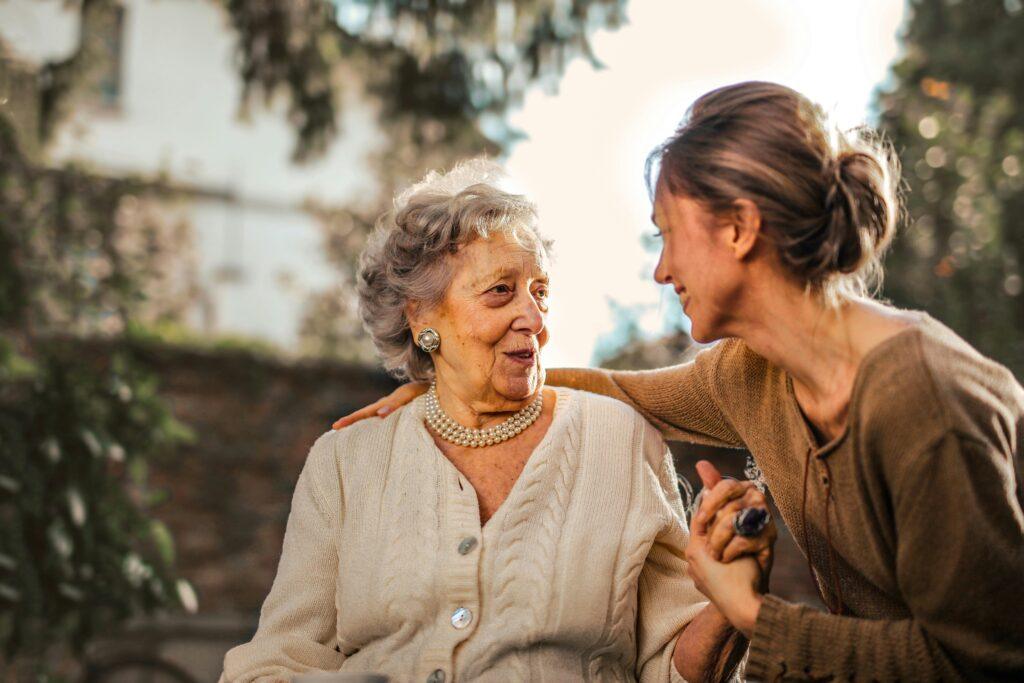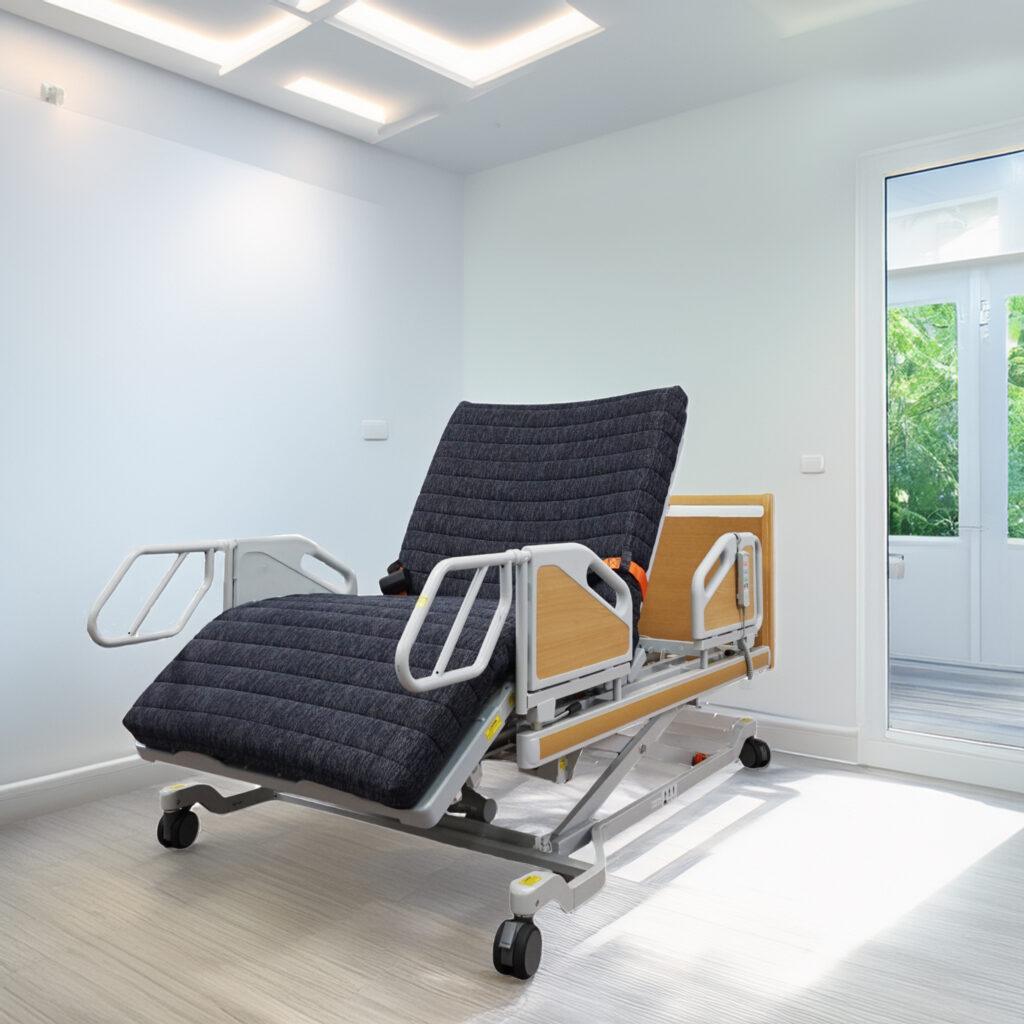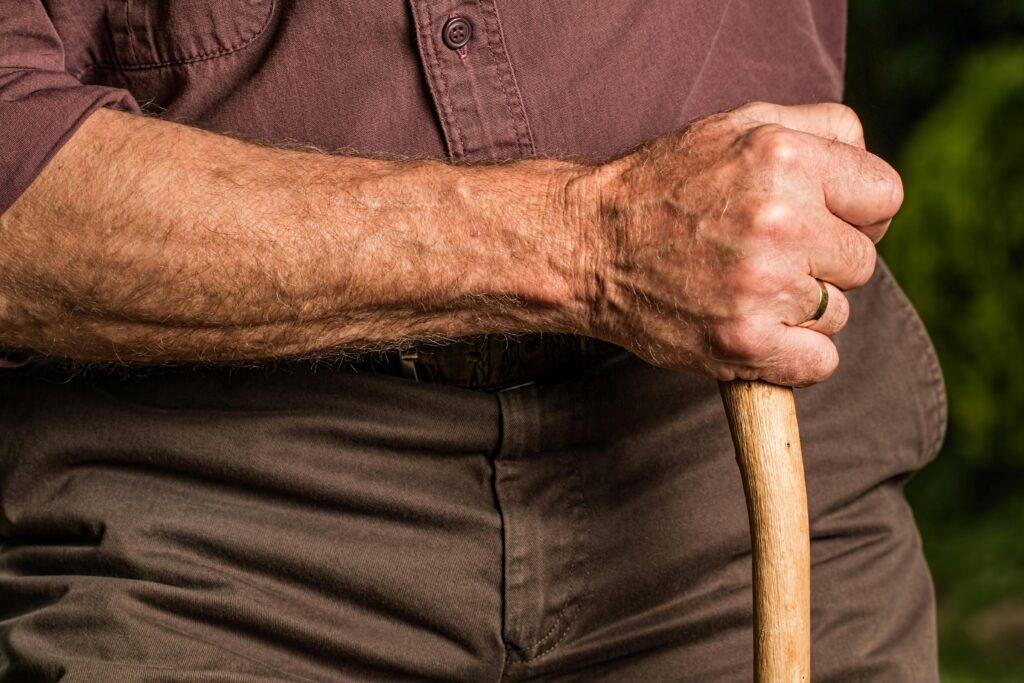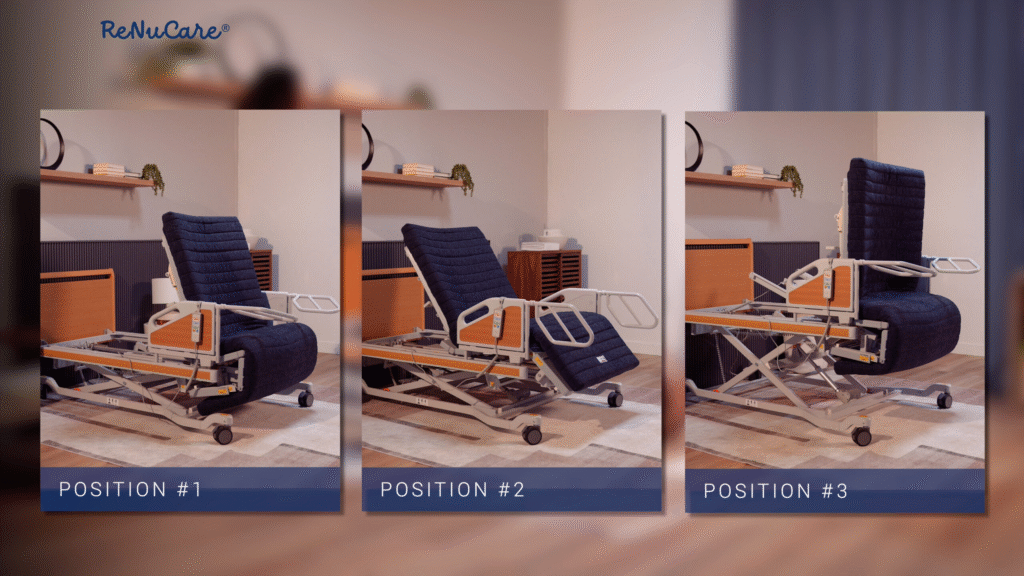
Caregiver’s Guide to Safe Bed Transfers at Home: Using the ReNuCare Standing Bed to Support Independence and Safety
Caring for a loved one at home comes with many responsibilities—one of the most important being safe bed transfers. Whether your loved one is recovering from surgery, managing a chronic condition, living with mobility limitations, or aging in place, helping them move from bed to a chair, wheelchair, or standing position can be both physically demanding and emotionally delicate. These moments often require more than just strength—they require patience, coordination, and care.
Unfortunately, many caregivers are not trained professionals, and the strain of lifting or repositioning someone incorrectly can result in serious injuries such as muscle strain, falls, or joint stress. These risks affect both the caregiver and the person receiving care, leading to long-term physical consequences or a decline in overall well-being. Beyond physical risks, unsafe or awkward transfers can also impact a person’s sense of dignity and independence—making them feel helpless or embarrassed.That’s why safe, consistent, and supportive transfer routines are essential to quality home care.
Fortunately, innovative solutions like the ReNuCare Standing Bed are revolutionizing the way we support our loved ones at home. This thoughtfully designed standing bed provides a much-needed bridge between independence and safety—making transfers easier, safer, and more dignified for everyone involved. With advanced lift functions, ergonomic design, and user-first features, the ReNuCare Standing Bed empowers individuals and relieves caregivers of unnecessary strain, creating a more sustainable and supportive care environment at home.

Why Safe Bed Transfers Matter
Manual transfers are one of the leading causes of caregiver injuries, especially to the back, shoulders, and joints. Many caregivers—whether family members or professionals—end up dealing with chronic pain or long-term strain simply from the repetitive motion of lifting, turning, or supporting a person during bed transfers. These tasks, when done without proper support or tools, can quickly become unsafe.
At the same time, the person being moved is also at risk. Without adequate support or stability, transfers can result in sudden slips, bruising, pulled muscles, or even dangerous falls. For individuals with limited mobility, weakened balance, or healing from surgery, even a minor mishap during a transfer can set back recovery or cause lasting discomfort.
Improper technique, lack of training, or absence of proper equipment can compound these risks—creating a stressful environment for both the caregiver and the loved one. It’s not just about the physical strain; it’s about the emotional toll, too. When transfers become moments of fear or tension, it affects the overall caregiving relationship.
That’s why it’s absolutely crucial to establish a transfer routine that’s gentle, ergonomic, and reliable. With the right equipment—like the ReNuCare Standing Bed—you create a safer, more supportive home care setting that protects both the caregiver’s health and the care recipient’s dignity and comfort. Investing in tools that prioritize safety not only prevents injury—it builds confidence, trust, and peace of mind in everyday care routines.

Meet the ReNuCare Standing Bed: Designed for Home Care
Unlike traditional hospital beds, the ReNuCare Standing Bed was designed specifically to support both caregivers and care recipients in the comfort of their own homes. Its sleek design blends medical-grade functionality with user-friendly technology, making it an ideal solution for long-term home care. Whether you’re a family caregiver or a professional aide, the ReNuCare bed helps ease the physical and emotional challenges of daily transfers.
With advanced features like adjustable standing support, customizable bed height, smooth electric controls, and secure grab bars, this bed doesn’t just provide mobility—it restores confidence and peace of mind. It transforms daily transfers from stressful tasks into safer, smoother moments that preserve dignity and strengthen independence.
Here’s how it helps:
- Standing Assist Functionality
The ReNuCare Standing Bed supports users in moving from lying to standing with the touch of a button. This empowers individuals to participate in their own mobility, helping maintain muscle strength and independence while reducing the need for physical lifting by caregivers. - Minimized Fall Risk
The secure frame, gradual lift function, and padded support handles help minimize the chance of falls during transitions—making it ideal for elderly users or those with balance issues. - Reduces Caregiver Strain
By automating the most strenuous part of a transfer—getting someone upright—the ReNuCare bed eliminates the need for heavy lifting or awkward postures, helping prevent caregiver burnout and injury. - Promotes Dignity and Comfort
Unlike traditional hoists or slings that can feel impersonal or clinical, the standing bed maintains a homey feel while promoting user dignity and autonomy.

Safe Transfer Tips for Caregivers
Even with an advanced bed like the ReNuCare Standing Bed, following safe and mindful practices during bed transfers is essential. While the technology reduces physical strain and enhances stability, human care, attention, and communication remain at the heart of a successful transfer. Incorporating best practices helps create a calm, safe environment that supports both physical and emotional well-being.
Here are key tips every caregiver should follow:
- Prepare the Space
Before every transfer, take a moment to scan the environment. Remove any loose rugs, cords, or clutter around the bed that could pose a tripping hazard. Ensure assistive devices—such as walkers, wheelchairs, or bedside commodes—are securely locked in place and within easy reach. Proper lighting is also crucial, especially in the evening or early morning hours, to help both you and your loved one see clearly and move with confidence.
- Communicate Clearly
Talk through each step before you begin. For example, say, “I’m going to help you sit up now,” or “Let’s take a moment before standing.” Clear, calm instructions help your loved one feel safe and included, and reduce anxiety. If they are able, encourage them to assist in small ways—such as gripping the side rails or placing their feet on the floor—to promote engagement and preserve a sense of independence.
- Use Proper Body Mechanics
Protect your own health while caring for others. When helping someone move or adjust, bend at your knees, not your back, and keep your spine aligned and core engaged. Avoid any sudden twisting or jerking motions. If you need to reach or lift, keep the person as close to your body as possible and move slowly and deliberately. Remember, the ReNuCare bed is designed to reduce strain—let it do the heavy lifting.
- Don’t Rush
Transfers should never feel hurried. Give your loved one time to adjust, especially when changing positions from lying down to sitting up or from sitting to standing. Their body may need a moment to recalibrate blood pressure, balance, or orientation—especially if they live with dizziness, fatigue, or neurological conditions. Pausing between steps not only enhances safety but also builds trust.
- Evaluate Regularly
Every person’s mobility and care needs evolve. Check in regularly—are they feeling more stable or less? Is their strength improving, or do they seem more fatigued than before? Use this information to adjust your approach or consult a healthcare provider if needed. Over time, you may want to explore additional support tools or modify routines to keep things as safe and comfortable as possible.
Caregiving is a journey of patience, learning, and compassion. By pairing best practices with supportive tools like the ReNuCare Standing Bed, you’re not just improving physical safety—you’re enhancing the quality of life for both you and your loved one.

Why It Matters
Regular cardio keeps your heart strong and your energy high—but its benefits go far beyond the physical. For wheelchair users, consistent aerobic activity helps reduce the risk of blood clots and pressure sores, promotes better digestion, enhances respiratory function, and improves mood and cognitive performance by releasing feel-good endorphins. It also plays a key role in maintaining muscle tone and stamina, both of which are crucial for mobility and daily independence.
More importantly, cardio reinforces a sense of empowerment. It reminds you that movement doesn’t have to look the same for everyone to be meaningful. You don’t need a treadmill, perfect form, or a high-tech gym to feel the rhythm of your body working for you.
It’s not about perfection—it’s about consistency, intention, and showing up for your body in whatever way you can. A few minutes of motion every day can compound into real, lasting change—physically, mentally, and emotionally.
So whether you’re dancing in your chair, shadowboxing in your living room, or rolling in timed intervals down a hallway, cardio becomes more than exercise—it becomes a celebration of your resilience, strength, and self-care.
Own your movement. Honor your body. And keep showing up—because you deserve to feel strong and alive, every single day.
Tips for Success
- Start slow: If you’re new to exercise, begin with 10–15 minutes a day.
- Listen to your body: Modify movements if you feel discomfort or strain.
- Stay consistent: A little every day adds up over time.
- Hydrate & fuel: Drink water and eat balanced meals to support recovery.
Tools that Can Help
- Resistance bands: Affordable and versatile for strength training
- Light hand weights: Ideal for biceps, shoulders, and triceps
- Timer apps: Keep track of exercise and rest intervals
Making Home Care Safer—and Smarter
The ReNuCare Standing Bed isn’t just a piece of furniture—it’s a daily partner in caregiving. Whether you’re helping a parent, spouse, or long-term patient, this advanced bed is designed to meet real, everyday challenges with compassion and precision. It provides peace of mind by reducing physical strain, minimizing the risk of falls, and offering dependable support during every transition.
More than a mobility aid, the ReNuCare Standing Bed represents a shift toward smarter, more dignified care. Safe bed transfers are no longer just about moving someone from one place to another—they’re about restoring a sense of autonomy, preserving emotional well-being, and protecting your own health as a caregiver. It transforms a routine task into a shared moment of safety, comfort, and connection.
Whether you’re new to caregiving or managing long-term home care, having the right tools makes all the difference. The ReNuCare Standing Bed helps you care with confidence—knowing your loved one is supported by equipment that puts their needs, comfort, and dignity first.
Explore more features of the ReNuCare Standing Bed here and discover how it can transform your home care routine into something safer, smoother, and more empowering for both you and the person you care for.

References
1. Caregiver Injuries and Transfer Risks
Source: Occupational Safety and Health Administration (OSHA) – “Safe Patient Handling”
- Key Point: Manual lifting of patients is a leading cause of musculoskeletal injuries among caregivers and healthcare workers.
- Link: OSHA – Safe Patient Handling
2. Fall Risks Among Older Adults
Source: Centers for Disease Control and Prevention (CDC) – “Older Adult Falls”
- Key Point: Falls are the leading cause of injury-related deaths among adults 65 and older; assistive devices and safer environments are critical in reducing these risks.
- Link: CDC – Falls Among Older Adults
3. Importance of Mobility and Independence in Aging
Source: National Institute on Aging (NIA) – “Maintaining Mobility and Preventing Disability”
- Key Point: Maintaining mobility through regular movement and assistive technologies can help preserve independence and delay the need for institutional care.
- Link: NIA – Maintaining Mobility
4. Emotional and Physical Impact of Caregiving
Source: Family Caregiver Alliance – “Caregiving and Stress”
- Key Point: Long-term caregiving without proper tools or support can lead to burnout, physical injury, and emotional exhaustion.
- Link: Family Caregiver Alliance – Caregiver Health
5. Assistive Technology Improves Quality of Life
Source: World Health Organization (WHO) – “Assistive Technology”
- Key Point: Assistive technology, such as adjustable beds and standing aids, plays a critical role in enhancing quality of life for people with functional difficulties.
- Link: WHO – Assistive Technology


